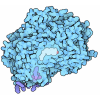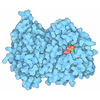[English] 日本語
 Yorodumi
Yorodumi- PDB-1tn8: Protein Farnesyltransferase Complexed with a H-Ras Peptide Substr... -
+ Open data
Open data
- Basic information
Basic information
| Entry | Database: PDB / ID: 1tn8 | ||||||
|---|---|---|---|---|---|---|---|
| Title | Protein Farnesyltransferase Complexed with a H-Ras Peptide Substrate and a FPP Analog at 2.25A Resolution | ||||||
 Components Components |
| ||||||
 Keywords Keywords | TRANSFERASE / FTase / farnesyltransferase / farnesyl transferase / prenyltransferase / CaaX / Ras / lipid modification / prenylation / substrate selectivity | ||||||
| Function / homology |  Function and homology information Function and homology informationApoptotic cleavage of cellular proteins / Inactivation, recovery and regulation of the phototransduction cascade / RAS processing / protein geranylgeranyltransferase activity / peptide pheromone maturation / protein farnesylation / protein geranylgeranyltransferase type I / CAAX-protein geranylgeranyltransferase activity / CAAX-protein geranylgeranyltransferase complex / protein farnesyltransferase ...Apoptotic cleavage of cellular proteins / Inactivation, recovery and regulation of the phototransduction cascade / RAS processing / protein geranylgeranyltransferase activity / peptide pheromone maturation / protein farnesylation / protein geranylgeranyltransferase type I / CAAX-protein geranylgeranyltransferase activity / CAAX-protein geranylgeranyltransferase complex / protein farnesyltransferase / protein farnesyltransferase activity / protein farnesyltransferase complex / Rab geranylgeranyltransferase activity / protein geranylgeranylation / regulation of fibroblast proliferation / regulation of microtubule-based movement / geranylgeranyl diphosphate synthase activity / positive regulation of skeletal muscle acetylcholine-gated channel clustering / acetyltransferase activator activity / microtubule associated complex / enzyme-linked receptor protein signaling pathway / positive regulation of Rac protein signal transduction / alpha-tubulin binding / positive regulation of cell cycle / wound healing / receptor tyrosine kinase binding / lipid metabolic process / positive regulation of fibroblast proliferation / fibroblast proliferation / microtubule binding / molecular adaptor activity / cell population proliferation / negative regulation of cell population proliferation / positive regulation of cell population proliferation / negative regulation of apoptotic process / enzyme binding / zinc ion binding / cytoplasm Similarity search - Function | ||||||
| Biological species |  | ||||||
| Method |  X-RAY DIFFRACTION / X-RAY DIFFRACTION /  MOLECULAR REPLACEMENT / Resolution: 2.25 Å MOLECULAR REPLACEMENT / Resolution: 2.25 Å | ||||||
 Authors Authors | Reid, T.S. / Terry, K.L. / Casey, P.J. / Beese, L.S. | ||||||
 Citation Citation |  Journal: J.Mol.Biol. / Year: 2004 Journal: J.Mol.Biol. / Year: 2004Title: Crystallographic analysis of CaaX prenyltransferases complexed with substrates defines rules of protein substrate selectivity. Authors: Reid, T.S. / Terry, K.L. / Casey, P.J. / Beese, L.S. | ||||||
| History |
|
- Structure visualization
Structure visualization
| Structure viewer | Molecule:  Molmil Molmil Jmol/JSmol Jmol/JSmol |
|---|
- Downloads & links
Downloads & links
- Download
Download
| PDBx/mmCIF format |  1tn8.cif.gz 1tn8.cif.gz | 171.2 KB | Display |  PDBx/mmCIF format PDBx/mmCIF format |
|---|---|---|---|---|
| PDB format |  pdb1tn8.ent.gz pdb1tn8.ent.gz | 130.8 KB | Display |  PDB format PDB format |
| PDBx/mmJSON format |  1tn8.json.gz 1tn8.json.gz | Tree view |  PDBx/mmJSON format PDBx/mmJSON format | |
| Others |  Other downloads Other downloads |
-Validation report
| Arichive directory |  https://data.pdbj.org/pub/pdb/validation_reports/tn/1tn8 https://data.pdbj.org/pub/pdb/validation_reports/tn/1tn8 ftp://data.pdbj.org/pub/pdb/validation_reports/tn/1tn8 ftp://data.pdbj.org/pub/pdb/validation_reports/tn/1tn8 | HTTPS FTP |
|---|
-Related structure data
| Related structure data | 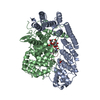 1tn6C 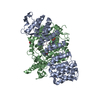 1tn7C 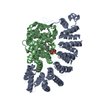 1tnbC 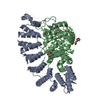 1tnoC 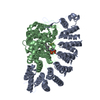 1tnuC 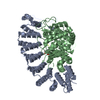 1tnyC 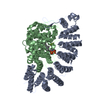 1tnzC  1d8dS S: Starting model for refinement C: citing same article ( |
|---|---|
| Similar structure data |
- Links
Links
- Assembly
Assembly
| Deposited unit | 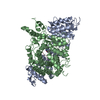
| ||||||||
|---|---|---|---|---|---|---|---|---|---|
| 1 |
| ||||||||
| Unit cell |
|
- Components
Components
-Protein , 2 types, 2 molecules AB
| #1: Protein | Mass: 44098.145 Da / Num. of mol.: 1 Source method: isolated from a genetically manipulated source Source: (gene. exp.)   |
|---|---|
| #2: Protein | Mass: 48722.281 Da / Num. of mol.: 1 Source method: isolated from a genetically manipulated source Source: (gene. exp.)   |
-Protein/peptide , 1 types, 1 molecules C
| #3: Protein/peptide | Mass: 477.576 Da / Num. of mol.: 1 / Mutation: K184G / Source method: obtained synthetically Details: peptide was chemically synthesized. The sequence of this peptide naturally exists in Homo sapiens(Human). |
|---|
-Non-polymers , 4 types, 317 molecules 

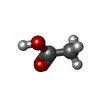




| #4: Chemical | ChemComp-ZN / |
|---|---|
| #5: Chemical | ChemComp-FII / [( |
| #6: Chemical | ChemComp-ACY / |
| #7: Water | ChemComp-HOH / |
-Experimental details
-Experiment
| Experiment | Method:  X-RAY DIFFRACTION / Number of used crystals: 1 X-RAY DIFFRACTION / Number of used crystals: 1 |
|---|
- Sample preparation
Sample preparation
| Crystal | Density Matthews: 3.119 Å3/Da / Density % sol: 60.6 % |
|---|---|
| Crystal grow | Temperature: 290 K / Method: vapor diffusion, hanging drop / pH: 5.7 Details: 14% PEG 8000, 600 mM ammonium acetate pH 5.7, 20 mM DTT, VAPOR DIFFUSION, HANGING DROP, temperature 290K |
-Data collection
| Diffraction | Mean temperature: 100 K |
|---|---|
| Diffraction source | Source:  ROTATING ANODE / Type: RIGAKU / Wavelength: 1.5418 Å ROTATING ANODE / Type: RIGAKU / Wavelength: 1.5418 Å |
| Detector | Type: RIGAKU RAXIS IV / Detector: IMAGE PLATE / Date: Jan 13, 2000 / Details: double mirror optics (MSC) |
| Radiation | Protocol: SINGLE WAVELENGTH / Monochromatic (M) / Laue (L): M / Scattering type: x-ray |
| Radiation wavelength | Wavelength: 1.5418 Å / Relative weight: 1 |
| Reflection | Resolution: 2.25→50 Å / Num. obs: 55180 / % possible obs: 100 % / Observed criterion σ(I): -3 / Redundancy: 6.5 % / Biso Wilson estimate: 24.1 Å2 / Rsym value: 0.11 / Net I/σ(I): 14.7 |
| Reflection shell | Resolution: 2.25→2.33 Å / Redundancy: 5.5 % / Mean I/σ(I) obs: 2.5 / Num. unique all: 5427 / Rsym value: 0.631 / % possible all: 99.9 |
- Processing
Processing
| Software |
| ||||||||||||||||||||||||||||||||||||
|---|---|---|---|---|---|---|---|---|---|---|---|---|---|---|---|---|---|---|---|---|---|---|---|---|---|---|---|---|---|---|---|---|---|---|---|---|---|
| Refinement | Method to determine structure:  MOLECULAR REPLACEMENT MOLECULAR REPLACEMENTStarting model: 1D8D Resolution: 2.25→37.06 Å / Rfactor Rfree error: 0.004 / Data cutoff high absF: 3369332.96 / Data cutoff low absF: 0 / Isotropic thermal model: RESTRAINED / Cross valid method: THROUGHOUT / σ(F): 0 / Stereochemistry target values: Engh & Huber
| ||||||||||||||||||||||||||||||||||||
| Solvent computation | Solvent model: FLAT MODEL / Bsol: 49.3338 Å2 / ksol: 0.376101 e/Å3 | ||||||||||||||||||||||||||||||||||||
| Displacement parameters | Biso mean: 41.7 Å2
| ||||||||||||||||||||||||||||||||||||
| Refine analyze |
| ||||||||||||||||||||||||||||||||||||
| Refinement step | Cycle: LAST / Resolution: 2.25→37.06 Å
| ||||||||||||||||||||||||||||||||||||
| Refine LS restraints |
| ||||||||||||||||||||||||||||||||||||
| LS refinement shell | Resolution: 2.25→2.39 Å / Rfactor Rfree error: 0.016 / Total num. of bins used: 6
| ||||||||||||||||||||||||||||||||||||
| Xplor file |
|
 Movie
Movie Controller
Controller


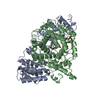
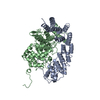
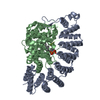
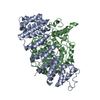

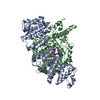
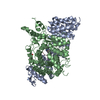
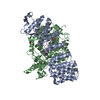
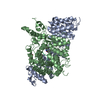
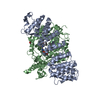
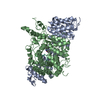
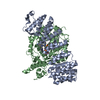
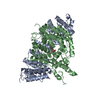
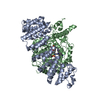
 PDBj
PDBj